
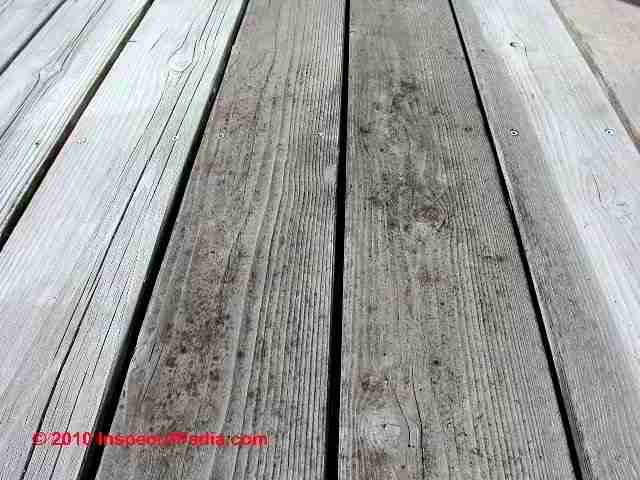 Finishes, Stains, Coatings, & Preservatives for Decks
Finishes, Stains, Coatings, & Preservatives for DecksThis article discusses the selection and application of deck stains, water repellents, paints, or other coatings.
Our page top photo shows a weathered-gray deck that was the subject of owner-complaints concerning black "mold" spots. It was determined that wax from citronella candles spilling on the surface was the culprit.
InspectAPedia tolerates no conflicts of interest. We have no relationship with advertisers, products, or services discussed at this website.
- Daniel Friedman, Publisher/Editor/Author - See WHO ARE WE?
All wood decking, whether pressure-treated or not, needs to be sealed at installation and periodically thereafter to prevent checking, warping, and deterioration of the surface due to exposure to water and sunlight. The chemicals in treated wood and the natural tannins in redwood and cedar resist decay and insect attack, but they will not stop checking and warping.
There are a wide array of deck finishes on the market, but they all consist of one or more of the following: water repellants, preservatives, UV blockers, pigments, and a drying oil or varnish base (see Table 4-9.)
[Click any image for an enlarged, detailed version.]
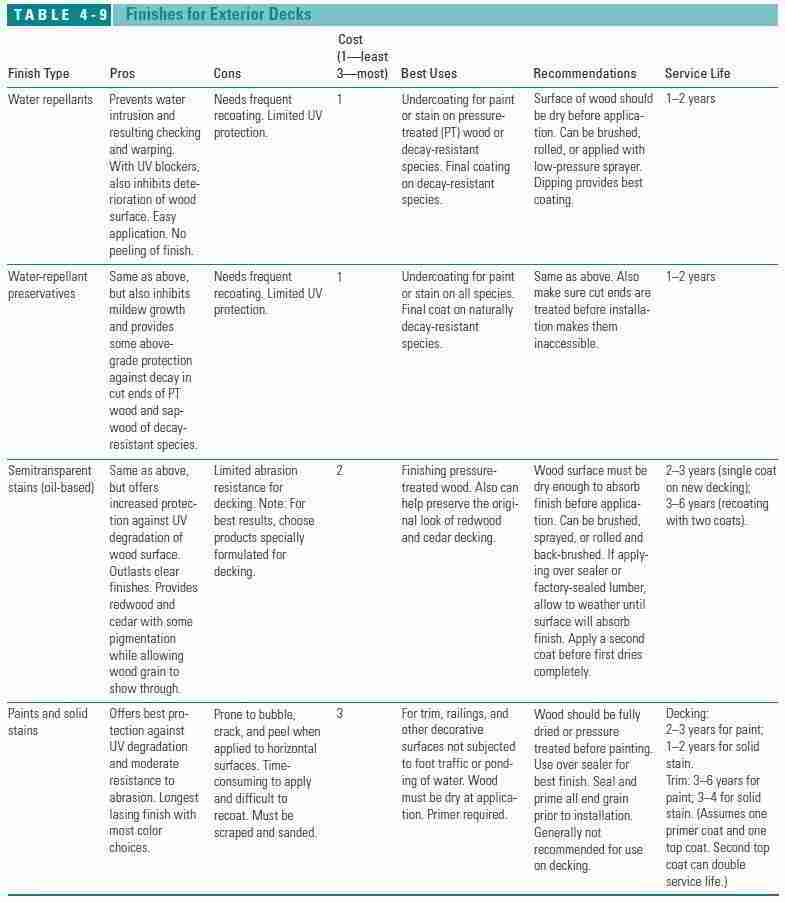
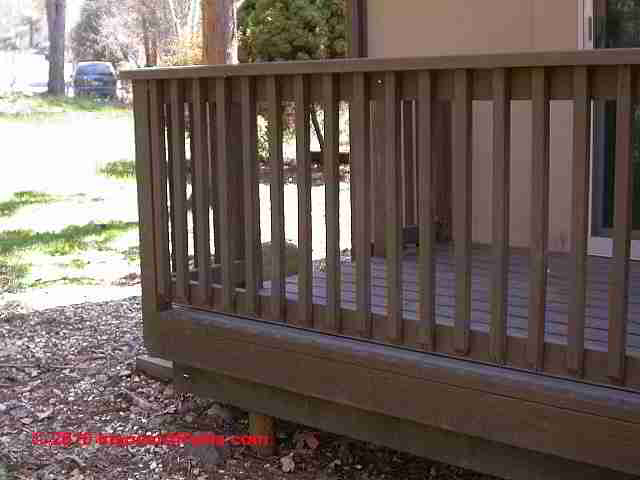 at a minimum, all wood decks should be treated with a
water-repellant coating, preferably a water-repellant preservative
(WRP), which has an added mildewcide.
at a minimum, all wood decks should be treated with a
water-repellant coating, preferably a water-repellant preservative
(WRP), which has an added mildewcide.
Also called “sealers,” these formulations typically contain a water-repelling wax and a varnish or drying oil, such as linseed or tung oil.
The finish penetrates and seals the wood surface, reducing the amount of water absorption and thereby protecting against checking, splitting, and warping. After application, water should bead up as on a newly waxed car.
Some water repellants contain a small amount of wax (about 1% by volume) and are intended as a pretreatment for other finishes.
Others contain up to 3% wax and are intended as a final coating. Some of these cannot be stained or painted over, so it is important to read the label.
WRPs, which have an added mildewcide [really it's a fungicide since mildew grows only on living plants], help prevent dark stains on natural woods like redwood and cedar, and on pressure-treated lumber as well. In addition, WRPs provide some protection against decay in the sapwood of redwood and cedar and in the cut ends of pressure-treated decking.
Some sealers and WRPs also have UV-inhibitors, an important addition if the sealer is the final coating, since this will help protect against deterioration of the wood surface from sunlight.
If a sealer or WRP is the only treatment used, the homeowner should plan to recoat every one to two years or whenever water on the surface no longer beads up and is quickly absorbed.
WRPs also make an excellent undercoat for semitransparent stains. The combination of a semitransparent stain over a WRP base coat provides the best long-term protection for decks. However, not all WRPs are suitable for use as an undercoat—so check the label or ask the manufacturer before proceeding.
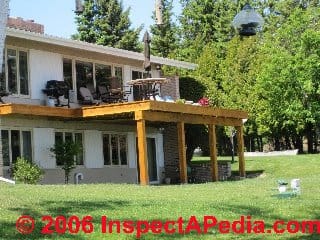 Oil-based semitransparent stains contain many of the same
ingredients as a WRP and penetrate the wood in the same
manner. The main difference is the addition of pigments,
which provide some color and help protect against
UV radiation.
Oil-based semitransparent stains contain many of the same
ingredients as a WRP and penetrate the wood in the same
manner. The main difference is the addition of pigments,
which provide some color and help protect against
UV radiation.
[The stained exterior deck shown at left has no guardrailings. Fortunately that's because its construction was incomplete - railings were added later.
Until the guardrails were installed this was an unsafe structure and should have had appropriately restricted access.
Some, such as Penofin (Performance Coatings Inc.), are very lightly pigmented but add UV inhibitors to achieve a similar level of protection.
Since oil based stains penetrate the wood surface, they will not peel, blister, or chip like paint. Stains formulated specifically for decks may have improved resistance against abrasion as well.
Stains are a good finish for either treated wood or naturally decay-resistant species. T
he pigment provides good protection against UV radiation and extends the life of the finish beyond that of a simple water-repellant or WRP.
Light-colored finishes will reflect more light and, therefore, tend to outlast darker colors on exposed surfaces.
For the stain to penetrate properly, the wood surface must be fairly dry when the stain is applied. If the decking material was factory-treated with a sealer or was recently sealed on-site, it may be necessary to wait two weeks or longer before staining. For best results, apply two coats of stain, with the second applied before the first coat completely dries.
Once dried, the first coat will block the proper penetration of the second coat.
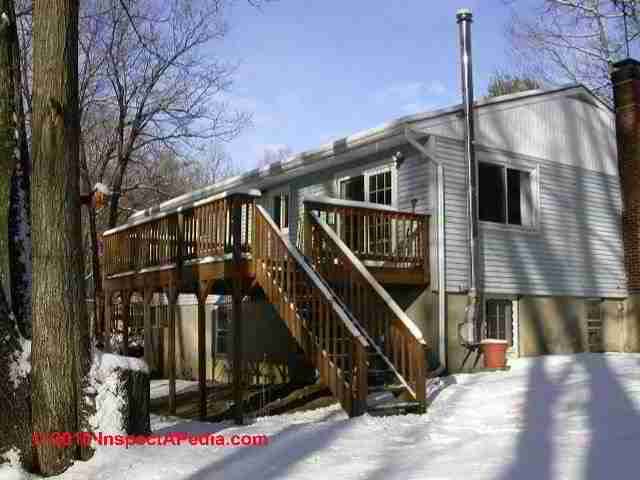 Paints and solid color
stains (also called “opaque” stains), whether latex or
oil-based, all form films on the wood surface.
Paints and solid color
stains (also called “opaque” stains), whether latex or
oil-based, all form films on the wood surface.
While these provide excellent protection against water penetration and UV degradation, they are not recommended for decking (flooring) for two main reasons:
While not recommended for the decking, paint may be applied successfully to other deck components, such as railings.
If the job calls for paint, take the following precautions: First, seal the wood with a water-repellant preservative formulated to serve as an undercoat. Make sure all end grain is sealed and primed prior to assembly, when it may become inaccessible.
After two to three weeks, when the surface is dry enough to paint, prime and paint the rest of the wood. A better alternative, if the budget allows, is to buy kiln-dried pressure-treated lumber, which can be sealed, primed, and painted immediately.
Kiln-dried pressure-treated lumber is marked KDAT (kiln-dried after treatment).
Woods such as redwood and cedar, which have a high level of extractives, require special stain-blocking primers, or the dark-colored extractives will bleed through and stain the painted surface.
While painters have traditionally preferred oil-based primers on wood species prone to extractive bleeding, new latex primers specially formulated for stain blocking may also do the job.
See Deck & Porch Products, Manufacturers for our complete/updated listings of manufacturers of porch & deck products, materials, coatings, fasteners, lumber, tools.
- - Adapted with permission from Best Practices Guide to Residential Construction (Steve Bliss, J Wiley & Sons) .
...
Continue reading at ROT-RESISTANT Deck Lumber & Flooring or select a topic from the closely-related articles below, or see the complete ARTICLE INDEX.
Or see these
DECK FINISHES COATINGS PRESERVATIVES at InspectApedia.com - online encyclopedia of building & environmental inspection, testing, diagnosis, repair, & problem prevention advice.
Or see this
Or use the SEARCH BOX found below to Ask a Question or Search InspectApedia
Or see
Or use the SEARCH BOX found below to Ask a Question or Search InspectApedia
Try the search box just below, or if you prefer, post a question or comment in the Comments box below and we will respond promptly.
Search the InspectApedia website
Note: appearance of your Comment below may be delayed: if your comment contains an image, photograph, web link, or text that looks to the software as if it might be a web link, your posting will appear after it has been approved by a moderator. Apologies for the delay.
Only one image can be added per comment but you can post as many comments, and therefore images, as you like.
You will not receive a notification when a response to your question has been posted.
Please bookmark this page to make it easy for you to check back for our response.
IF above you see "Comment Form is loading comments..." then COMMENT BOX - countable.ca / bawkbox.com IS NOT WORKING.
In any case you are welcome to send an email directly to us at InspectApedia.com at editor@inspectApedia.com
We'll reply to you directly. Please help us help you by noting, in your email, the URL of the InspectApedia page where you wanted to comment.
In addition to any citations in the article above, a full list is available on request.